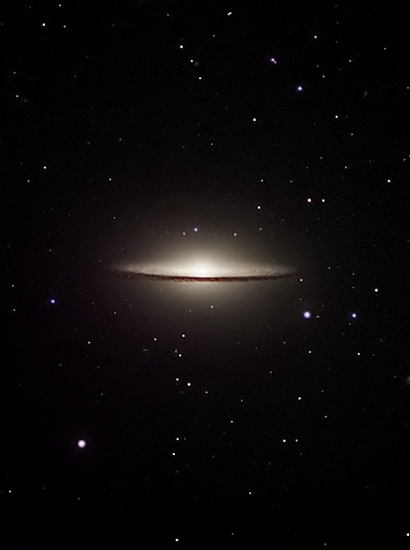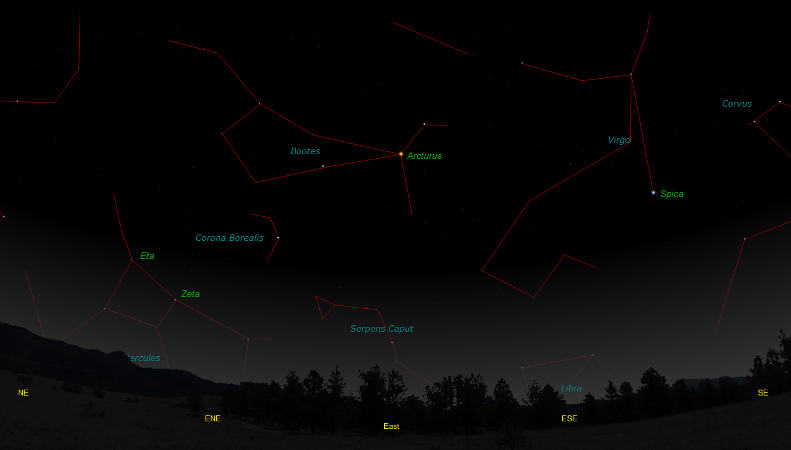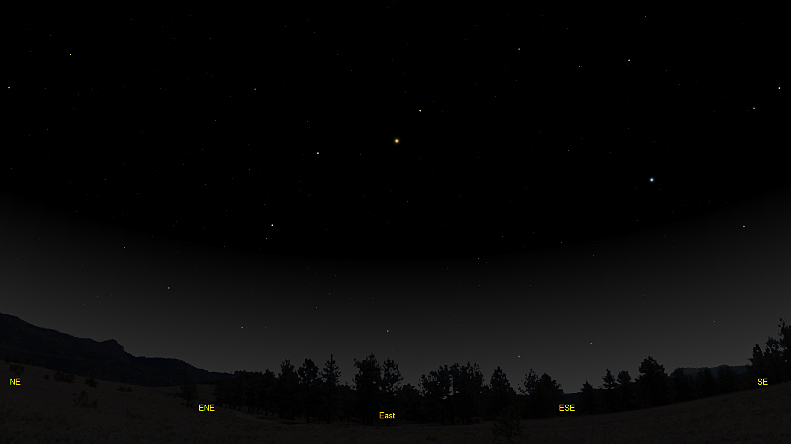The purpose of this feature is to give scout leaders, educators and naturalists an idea of some of the natural events coming up each month. We will try to cover a variety of natural events ranging from sky events to calling periods of amphibians, bird and mammal watching tips, prominent wildflowers and anything else that comes to mind. We will also note prominent constellations appearing over the eastern horizon at mid-evening each month for our area for those who would like to learn the constellations. If you have suggestions for other types of natural information you would like to see added to this calendar, let us know! Note: You can click on the hyperlinks to learn more about some of the featured items. To return to the Calendar, hit the "back" button on your browser, NOT the "back" button on the web page. All charts are available in a "printer friendly" mode, with black stars on a white background. Left clicking on each chart will take you to a printable black and white image. Please note that images on these pages are meant to be displayed at 100%. If your browser zooms into a higher magnification than that, the images may lose quality.
Notes and Images From March 2009
The great galaxy Messier 104 is in southern Virgo, but I like to think of it as perched on the shoulder of Corvus, the crow. It lies just outside of the boundaries of that constellation. There is a faint line of stars just above the four brightest stars of Corvus that form an arrow that points to the location of the famous galaxy. If you know where to look and have dark skies, you may be able to just pick it out with binoculars. A small telescope will usually reveal the nucleus and the dark edge of the dust clouds that cut across its face. The dust lane will not appear as sharply defined as it does in the image at right, taken on March 30th. Instead, you will first notice that the soft glow of the nucleus seems to drop off very suddenly in brightness on one side. If you look to one side of the galaxy and use averted vision, you will see more of the dust lane's silhouette. To see the dim outlines of the galaxy while you are surrounded by the sounds of a spring evening is a very pleasant experience. Nicknamed the Sombrero Galaxy, M104 is about 30 million light years distant. Measurements of the motions of stars near the nucleus of the galaxy indicate that the core contains a massive black hole with a mass of around one billion Suns.
Sky Events for April 2009: Evening Sky: Saturn is already high in the southeastern sky at dusk at the beginning of April. This month is a great opportunity to view this magnificent planet. The rings are almost edge-on, tilted between three and four degrees. Because of the diminished brightness of the ring system, you may be able to see fainter satellites of Saturn than you normally do with a given telescope. Mercury has a fine apparition this month, and may be seen low above the west-northwest horizon from the middle of the month to the end of the month. It reaches greatest elongation from the Sun on April 26th. On that evening the Pleiades will be just below a thin waxing crescent Moon, and Mercury will be below the Pleiades. It should be a beautiful sight! Try looking for the group about 45 minutes after sunset. Morning Sky: The Lyrid Meteor Shower occurs in the pre-dawn hours of April 22nd. Although this typically is a fairly weak shower, you may want to give it a try. Best conditions will be between 1:00am and 4:00am. Look northeast towards the bright star Vega. Jupiter is visible in the dawn sky in April. It rises around 3:30am at mid-month. Mars apparent size is quite small right now, only about 4.4 seconds of an arc in diameter. It rises around 5:00am at mid-month. Venus gradually climbs away from the sun in the morning twilight this month, and should make a pretty pairing with the waning crescent Moon on April 22nd. Look above the eastern horizon about 40 minutes before sunrise.
Constellations: The views below show the sky looking east at 9:30pm CDT on April 15th. The first view shows the sky with the constellation outlined and names depicted. Star and planet names are in green. Constellation names are in blue. The second view shows the same scene without labels. New constellations this month in the eastern sky are Serpens Caput, the Serpent (Head), and Hercules, the Strongman. As spring progresses and Hercules rises higher in the sky, look for the globular cluster Messier 13 (M13), which appears like a small fuzzy patch of light about 1/3 of the distance from Eta to Zeta Hercules (see illustration below). A cluster of stars about 21,000 light years away, M13 can be made out with the naked eye in a dark country sky when the constellation is high in the sky. Binoculars help pick it out.
On Learning the Constellations: We advise learning a few constellations each month, and then following them through the seasons. Once you associate a particular constellation coming over the eastern horizon at a certain time of year, you may start thinking about it like an old friend, looking forward to its arrival each season. The stars in the evening scene above, for instance, will always be in the same place relative to the horizon at the same time and date each April. Of course, the planets do move slowly through the constellations, but with practice you will learn to identify them from their appearance. In particular, learn the brightest stars (Like Arcturus and Spica in the above scene looking east), for they will guide you to the fainter stars. Once you can locate the more prominent constellations, you can "branch out" to other constellations around them. It may take you a little while to get a sense of scale, to translate what you see on the computer screen or what you see on the page of a book to what you see in the sky. Look for patterns, like the stars that make up the constellation Corona Borealis. The earth's rotation causes the constellations to appear to move across the sky just as the sun and the moon appear to do. If you go outside earlier than the time shown on the charts, the constellations will be lower to the eastern horizon. If you observe later, they will have climbed higher. As each season progresses, the earth's motion around the sun causes the constellations to appear a little farther towards the west each night for any given time of night. If you want to see where the constellations in the above figures will be on May 15th at 9:30pm CDT, you can stay up till 11:30pm CDT on the April 15th and get a preview. The westward motion of the constellations is equivalent to two hours per month. Recommended: Sky Publishing has a beautiful and compact star atlas, the Sky & Telescope's Pocket Star Atlas. It is destined to become a classic, and is a joy to use at the telescope. A good book to learn the constellations is Patterns in the Sky, by Hewitt-White. You may also want to check out at H. A. Rey's classic, The Stars, A New Way to See Them. For skywatching tips, an inexpensive good guide is Secrets of Stargazing, by Becky Ramotowski. A good general reference book on astronomy is the Peterson
Field Guide,
A Field Guide to the Stars and Planets, by Pasachoff. The book retails for around $14.00. Starry Night has several software programs for learning the night sky. Visit the Starry Night web site at www.starrynight.com for details.
Amphibians:
Already this spring we've heard Upland Chorus Frogs, Spring Peepers, Southern Leopard Frogs, American Toads, and Northern Cricket Frogs. Listen on warm days for American Bullfrogs, Green Frogs, and Cope's Gray Treefrogs. The early calls of Gray Treefrogs sound raspier than the normal trill, as if the frog needs to clear its throat. They sometimes call from small tree cavities on warm days. Early April is also great time to listen for the "yeeooww" calls of Pickerel Frogs.
Birds: The spring migration builds very quickly in April. The neo-tropical migrants are too numerous to list here, but now is the time to get out in the early morning with a pair of binoculars and welcome the new arrivals for the day. Early arrivals include Black-and-white Warbler, Black-Throated Green Warbler, Louisiana Waterthrush and Blue-gray Gnatcatcher. Listen at dusk for young Great Horned Owls and Young Barred Owls, doing their raspy "begging" calls. Recommended: Bird Finding in Tennessee, Michael Lee Bierly. A classic guide to finding birds in Tennessee. The Sibley Guide to Birds, David Allen Sibley The Sibley Guide to Birds of Eastern North America, David Allen Sibley An inexpensive guide for beginners is the Golden Guide for Birds.
Wildflowers: Some of our favorite Spring wildflower walks are: The south ridge at the Owl's Hill Nature Center in Brentwood, Tennessee. The Edwin Warner paved loop at the Warner Parks in Nashville or just about any trail in Warner Parks. The Angel Falls trail along the Cumberland River at the Big South Fork Recreational Area, near Jamestown, Tennessee.
Archives (Remember to use the back button on your browser, NOT the back button on the web page!) Natural Calendar February 2009 Natural Calendar December 2008 Natural Calendar November 2008 Natural Calendar September 2008 Natural Calendar February 2008 Natural Calendar December 2007 Natural Calendar November 2007 Natural Calendar September 2007 Natural Calendar February 2007 Natural Calendar December 2006 Natural Calendar November 2006 Natural Calendar September 2006 Natural Calendar February 2006
Natural Calendar
December 2005
Natural Calendar
November 2005
Natural Calendar
September 2005
Natural Calendar
February 2005
Natural Calendar
December 2004
Natural Calendar
November 2004
Natural Calendar
September 2004
Natural Calendar
February 2004
Natural Calendar
December 2003
Natural Calendar
November 2003
Natural Calendar
September 2003 Natural Calendar February 2003 Natural Calendar December 2002 Natural Calendar November 2002 Nature Notes Archives: Nature Notes was a page we published in 2001 and 2002 containing our observations about everything from the northern lights display of November 2001 to frog and salamander egg masses. Night scenes prepared with The Sky Professional from Software Bisque All images and recordings © 2009 Leaps |




